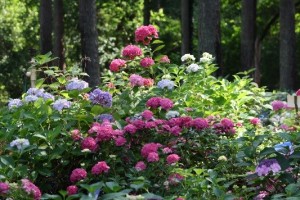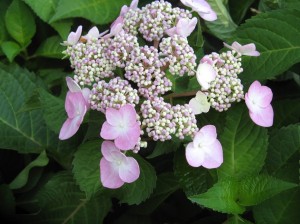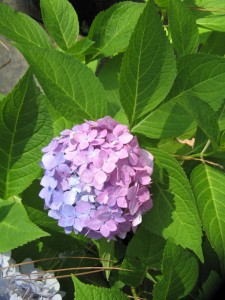by Julie McConnell | May 2, 2013

Hydrangeas
Bigleaf Hydrangea (Hydrangea macrophylla) are familiar faces in the southern shade garden. Although not originally from North America, they were introduced here over 200 years ago and perform well in the climate of the Florida Panhandle. Here are some quick tips about Bigleaf Hydranges.
- Hydrangeas prefer morning sun with afternoon shade or full shade and well-drained, moist soil
- The form is a mounding shrub that can have varying heights and widths, allow for a mature size on average of 6′ x 6′
- Hydrangeas have large green leaves that may be glossy or dull and are deciduous unless the winter is very mild
- There are two main flower types:mophead and lacecap

Lacecap Hydrangea
- Mophead flowers are rounded and usually composed of sterile flowers, with a few fertile flowers
- Lacecap flowers have sterile flowers on the outer edge of the circle, with fertile flowers in the center. When fertile flowers are fertilized they may turn a different color and the sterile flowers on the outer edge may invert themselves so they appear to be hanging down
- Flowers may be white, pink, purple, or blue; flower color is influenced by soil conditions and you may see multiple colors on the same plant!

Penny Mac Hydrangea
- Bigleaf hydrangeas generally bloom on old wood, however, there are some types that will also bloom on new wood and fall into either “free-flowering” or “everblooming” categories. Free-flowering have flower buds on the tips of branches (old wood) and develop flower buds up and down the stem that flower after terminal (tip) buds flower. Everblooming hydrangeas form flower buds on the tips of both old wood and new wood and can flower throughout the season.
- If soils are sandy and infertile, add organic matter before planting
- Water as needed, especially during establishment phase (typically first year or two). Expect hydrangeas to wilt during hot summer afternoons, as with any plant check the soil moisture before irrigating to avoid overwatering
- Avoid overhead irrigation, leaf spot diseases and powdery mildew are more prevalent when foliage is wet for extended periods
- Prune after flowering, but before August when shaping is neededFor more information about long flowering hydrangea varieties see “New Hydrangeas for North and Central Florida: Bigleaf and Mountain Hydrangeas”
To learn more about influencing flower color and general care of hydrangeas read “French Hydrangea for Gardens in North and Central Florida.”
by | May 10, 2012

Robert C Trawick
Extension Horticulturist II
Jackson County
rob.trawick@ufl.edu
In May we move from the warm days and cool nights of spring and early summer to the hot days and warm nights that will be with us until, at the very least, September.
With the increasing heat, you’ll inevitably notice the decline of your cool-season bedding plants. After months of outstanding bloom, plants such as pansies, dianthus, alyssum, snapdragons and petunias are growing tired and unattractive.
But that’s OK. This change brings the opportunity to redesign and replant flower beds with bedding plants that will thrive during the hot summer season.
Don’t allow plantings of cool-season bedding plants to go too far down the road to oblivion before you decide to pull them out and replace them. Beds of colorful flowers are meant to be noticed and appreciated, and they generally are located in prominent spots in the landscape. A few lingering flowers in an otherwise disheveled bed will not contribute anything positive to your landscape’s appearance.
Once you have decided the time is right to replant, there are a few decisions you should make before you head out to the nursery.
Note the amount of light the bed receives; this is critical in selecting the right bedding plants for the area. The terms full sun (8 hours or more of direct sun), part sun (about 6 hours of direct sun), part shade (about 4 hours of direct sun), shade (about 2 hours of direct sun) and full shade (little or no direct sun) are used to distinguish various light conditions. Even bedding plants for shade generally will not do well in full shade, but fortunately areas of full shade are not terribly common in most landscapes.
Look at the size of the area to be planted, and try to estimate how many plants will need to be purchased. On average, bedding plants are spaced about 8 inches apart. Keep a record of how many plants are used in a bed from one season to the next to make this process simpler. Also, consider desired heights of the plants you will use.
Decide on a color scheme. It’s crazy that gardeners who take the time to choose which colors to combine when they get dressed will grab anything in bloom at the nursery and plant those things together in a flower bed. No one can tell you what colors you should use in your flowerbeds – you know what you like. The point is to think about it and consider which colors you think will look good together. Generally, avoid purchasing bedding plants in cell packs of mixed colors so you have control over which colors you will combine.
Prepare your beds carefully before putting in the summer bedding plants. A common mistake is to remove the faded plants, half-heartedly turn the soil and then plant the new plants. We must give back to the soil if we expect each new planting of bedding plants to do their best.
To prepare the bed, first remove any weeds or other unwanted plants from the bed. Use a herbicide, such as glyphosate, or dig them out by hand. Turn the soil to a depth of at least 8 inches. Spread a 2-inch to 4-inch layer of compost, rotted leaves, aged manure, finely ground pine bark or peat moss over the bed. Then evenly sprinkle a light application of a granular all-purpose fertilizer. Or use your favorite organic fertilizers. Thoroughly blend the organic matter and fertilizer into the bed, rake smooth and you’re ready to plant.
Of course, make sure you plant the transplants into the bed no deeper than they were growing in their original container.
Bedding plants are commonly purchased in cell packs and 4-inch pots, but these days you can even find them offered in gallon containers (for those who have the budget to indulge in instant gratification).
Transplants in cell packs are the most economical and if planted this early in the season, they have plenty of time to grow and produce spectacular results. For larger transplants, choose 4-inch pots, but expect to pay several times more per plant. Sometimes it’s worth it, especially for tender perennials grown as annuals, such as pentas, blue daze and lantana, which generally are offered only in 4-inch or larger pots.
Tender perennials grown as annuals are especially good for the summer flower garden. They have the stamina to last reliably from now until October or November – when you can replace them with cool-season bedding plants.
Warm-season bedding plants, as well as tender perennials that can be used as warm-season bedding plants, for sun to part sun include abelmoschus, ageratum, amaranthus, balsam, blue daze, celosia, cleome, coleus (sun-tolerant types), coreopsis, cosmos, dahlberg daisy, Dusty Miller, gaillardia, gomphrena, lantana, lisianthus, marigold, melampodium, narrow-leaf zinnia, ornamental pepper, periwinkle, pentas, portulaca, purslane, rudbeckia, salvia, scaevola, sunflower, tithonia, torenia, verbena (hardy perennial) and zinnia.
Some of the warm-season bedding plants and tender perennials for part-shade to shade are balsam, begonia, browallia, caladium (perennial tuber), cleome, coleus, impatiens, pentas, salvia and torenia.




